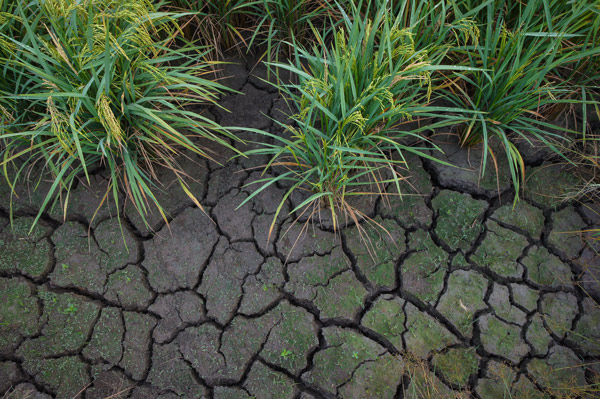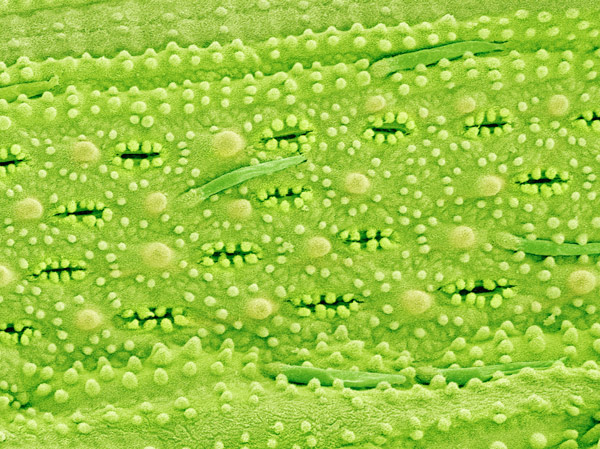Dec. 20, 2022 Feature Highlight Biology
Ethanol preps rice and wheat for drought
A cost-effective soil treatment could increase the survival rate of water-stressed crops more than ten-fold by reducing water loss and increasing sugar production in the aftermath.

Adding ethanol to soil helps to protect plants from the increasing incidence of drought conditions, which have risen globally by almost a third since 2000. Shaifulzamri Masri/EyeEm/Getty Images; Alice Design/The Noun Project
The northern hemisphere summer of 2022 has been a brutally hot one—China suffered its most severe heatwave in six decades, water in western Europe’s River Rhine dropped so low that big ships couldn’t pass through and the Horn of Africa experienced low rainfall for a fourth consecutive season. The events followed on the heels of a stark warning issued by the United Nations in May: the world has experienced a 29% increase in the duration and frequency of drought since 2000. We must now, they urged, use “every tool we can” to halt its rise. Droughts spell disaster on many levels—not only is it the deadliest natural disaster (killing more than 650,000 people between 1970 and 2019), it is also a major threat to our food production.
“Water scarcity is a serious agricultural problem that causes significant losses to crop yield and quality,” says Motoaki Seki, a plant scientist at the RIKEN Center for Sustainable Resource Science. “Because droughts are happening more frequently, we need to find a way to prevent plants from dying when it’s extremely dry.”
At present, the main approach involves genetically modifying plants to ensure their stomata—tiny pores in leaves and stems—remain shut, thus minimizing water loss. But this technique is time consuming, costly, and is not publicly accepted in many countries, says Seki.
Instead, he and his team, alongside local and international collaborators, propose an alternative, novel solution: apply ethanol to the soil to protect plants from drought. The approach, they observed in a recent study, helped plants—including popular crops, rice and wheat—survive water-deficient conditions1. “Ethanol is a simple and cheap compound, one that has been widely used as a disinfectant during COVID-19,” says Seki.
Ethanol the protector
Seki and his team arrived at ethanol somewhat serendipitously. “In searching for compounds that make plants resistant to stress, we were exploring the easy-to-access organic solvents that are commonly used to dissolve compounds during experiments,” he recalls.
Ethanol seemed a good bet, given that some plants naturally produce the colorless liquid in times of stress. Pine trees, for instance, are known to synthesize ethanol when damaged by wildfires, allowing them to continue breaking down sugars to produce energy. On the other end of the spectrum, rice seedlings have been observed producing ethanol when exposed to chilly temperatures, which helps improve their tolerance to the cold and possibly reduces membrane damage.
Seki’s team began experimenting with ethanol, and, in 2017, they discovered that the compound, in situations of high salinity, helped to protect rice and Arabidopsis thaliana, a small flowering plant widely used as a model organism in plant biology. Could ethanol possibly do the same in conditions of drought, they wondered?
To test their hypothesis, the researchers first grew rice and wheat plants with ample water for two weeks. Next, they added ethanol to the soil for three days, before withdrawing water for the final four days and two weeks for rice and wheat, respectively. The results were unequivocal: approximately 75% of ethanol-treated plants survived after rewatering following the drought. By comparison, fewer than 5% of untreated plants lived.

Both genetically modifying plants and applying ethanol treatments to the soils in which they grow help to ensure that plant stomata—tiny pores in leaves andstems—remain shut, minimizing water loss. Micro Discovery/Getty Images
Chemical priming
To determine why this was the case, Seki and his team examined how the plants’ physical attributes and gene expression changed with time, using the model plant A. thaliana.
“In ethanol-treated plants, there seems to be two phases of drought stress response,” he explains.
In the early phase, genes related to drought tolerance are upregulated—even before water deprivation begins, giving plants a head start to deal with the dry conditions ahead. Leaf temperatures also increase, indicating the surface stomata were closing. Narrowed or closed stomata help reduce the rate of transpiration, the process through which a plant takes liquid water from the soil and releases it as water vapors into the air from their leaves. Reduced transpiration delays water loss, adds Seki. Indeed, ethanol-treated plants were observed to have higher water levels in their leaves after 11 days of water deprivation compared with their non-treated counterparts.
All this indicated that ethanol primes the cellular environment so that the plant is better prepared to withstand drought stress, Seki notes.
In the later stages of drought stress, drought-induced genes start to become downregulated. At the same time, those related to photosynthesis as well as sucrose and starch metabolism are ramped up. The result? The ethanol-treated plants began accumulating sugars, including some that are made from the excess ethanol, which provides these plants with extra energy to sustain their growth.
“We find that the external application of ethanol enhances drought tolerance in all plant species tested—Arabidopsis, rice, and wheat,” concludes Seki. “Ethanol offers us a cheap and easy way to increase crop yield even when water is limited, without the need for genetic modification.”
Next up, his team plans to examine the molecular mechanisms of ethanol-mediated stress tolerance in greater detail, in the hopes of “revealing undiscovered players” in the pathways involved.
The overall aim is to develop stress-tolerant plants by use of chemical compounds, says Seki. “Through our study of stress adaptation and resistance, we would like to contribute to solving the global food crisis brought about by climate change due to global warming and achieving the Sustainable Development Goals.”
Rate this article
Reference
- 1. Bashir, K., Todaka, D., Rasheed, S., Matsui, A., Ahmad, Z. et al. Ethanol-mediated novel survival strategy against drought stress in plants Plant & Cell Physiology 63, 1181–1192 (2022). doi: 10.1371/10.1093/pcp/pcac114
About the researcher
Motoaki Seki

Motoaki Seki began his academic career with a degree from the Faculty of Agriculture at Kyoto University in Kyoto, Japan. He then obtained his PhD at Hiroshima University in 1994. Seki joined RIKEN in 1995 and started studying plant environmental stress adaptation under drought, heat, high-salinity and cold stresses. He has been leading the Plant Genomic Network Research Team at the RIKEN Center for Sustainable Resource Science (CSRS) (formerly, RIKEN Plant Science Center) since 2006. His research interests include the molecular mechanisms of plant environmental stress adaptation, the regulatory networks of tuberous root development in cassava and technology development for useful plants, such as enhanced stress tolerance and improved plant productivity. He has been a Clarivate Highly Cited Researcher in the field of Plant & Animal Science since 2014.
